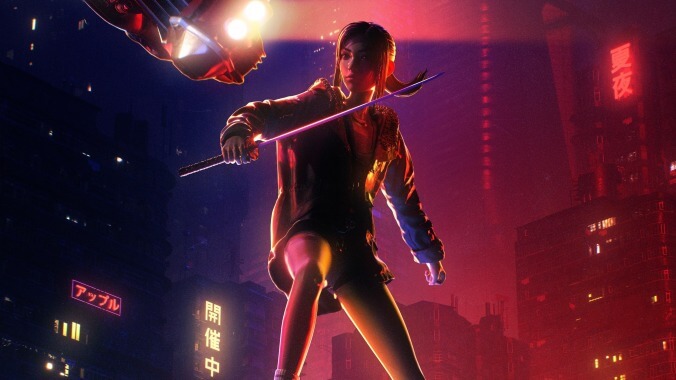Blade Runner: Black Lotus is a fine replication of Blade Runner and nothing more
The first full-length Blade Runner anime series, which stars Jessica Henwick and Brian Cox, is cool but there's not much else to it

It owes a lot to anime and cyberpunk and film noir, but Ridley Scott’s Blade Runner easily has some of the most iconic aesthetics of any movie ever. Nearly 40 years after the film was released (and two years after it takes place), the rain-soaked streets of future Los Angeles, lit only by the neon lights of an Atari billboard, are still incredibly impressive. Throw in the many trench coats, inexplicable architectural trends (pyramids come back in a big way), and those incredible light-up umbrellas, and everything except the explicit class disparity and mistreatment of replicants in Blade Runner is simply extremely cool.
Which is all to say that a lot of the groundwork has already been done for the Blade Runner: Black Lotus anime. The Adult Swim/Crunchyroll series is also very concerned with being cool, which it accomplishes simply by incorporating the Blade Runner name and successfully evoking the imagery and music of the movies—both Scott’s original and Denis Villeneuve’s Blade Runner 2049—but that’s the bare minimum of what it should set out to do.
Unfortunately, at least in its early going, there’s not a ton to recommend here beyond the fact that Black Lotus feels like Blade Runner and—despite taking place in the past for the anime—the original Blade Runner is as stylistically and thematically relevant as ever. Only three episodes were made available for review, leaving a whole lot of a TV show to go, but the best thing about these episodes is often the way they play with the Blade Runner toy box (replicants, Voight-Kampff tests, those incredible umbrellas) instead of the new characters or storylines they introduce.
The main new character is an amnesiac young woman who only knows two things: her name and an address. Elle (Jessica Henwick) remembers her home being on a sunny street surrounded by trees, which doesn’t make any sense in the dystopia of Blade Runner’s perpetually gloomy Los Angeles. She’s never heard of replicants or the blackout that serves as a bit of backstory in 2049 (as depicted in Cowboy Bebop creator and Black Lotus producer Shinichirō Watanabe’s excellent Black Out 2022 anime short), but she also displays a mysterious Jason Bourne-esque talent for very brutal and stylized murder.
These early episodes center on Elle following some breadcrumbs to learn about her past with help from a gruff tech expert who is clearly hiding from some dark stuff in his past, and a black market junk dealer named Doc Badger (Barkhad Abdi, reprising his 2049 role), but it all feels a bit straightforward. Elle has periodic flashbacks, and while one is sufficiently intriguing (it involves someone giving her the black lotus tattoo she has on her shoulder), the one that gets more attention in the early plot will be easy to figure out long before Elle actually puts the pieces together.
One wild card that Black Lotus does have up its sleeve, though, is the villainous machinations of the Wallace Corporation, led by Brian Cox’s Niander Wallace Sr. and Wes Bentley’s Niander Wallace Jr. (played by Jared Leto in 2049). At this point in the Blade Runner timeline, replicants have been deemed illegal and—wink wink—definitely aren’t being secretly produced by anyone, but we know that the younger Wallace will change that by 2049 and develop a deranged god complex when it comes to his many replicant children.
It’s interesting to see shades of Leto’s unnerving performance here—Wallace is a full-on creep in the movie and just a medium creep here, so the show will hopefully find something productive to do with this as its mysteries unfold (especially since the elder Wallace is literally voiced by the dad from Succession).
Speaking of Cox, he does a good job with the little time he gets in the early episodes, but the other voice actors leave a bit to be desired. Henwick’s Elle is fine, but there’s a slightly odd disconnect between her face and her vocal performance. She has the sort of cold and guarded vibe of other Blade Runner protagonists, but her face has the big eyes and heavily stylized features of an anime character. Combine that with the show’s use of motion-captured physical acting, and the characters move and talk like people but don’t always look like people.
Virtually every single frame of Black Lotus looks incredible, and most of the character designs are striking: An early scene involves Elle raiding Doc Badger’s stash of junk for clothes, and she just happens to put together an extremely badass ensemble. But things starts to feel stilted when characters are just talking—which, this being a Blade Runner offshoot, happens more often than the shootouts and sword fights.
The main issue with Blade Runner: Black Lotus is that there isn’t really a compelling hook here aside from the Blade Runner bit in the title. It’s a competently assembled tie-in to the larger mythology, but, at least in these early episodes, it’s not clear if there’s much to it beyond that. The good news for Black Lotus is that simply achieving that is pretty impressive on its own, but as with shopping for replicants, you generally want to aim higher than “competently assembled.”